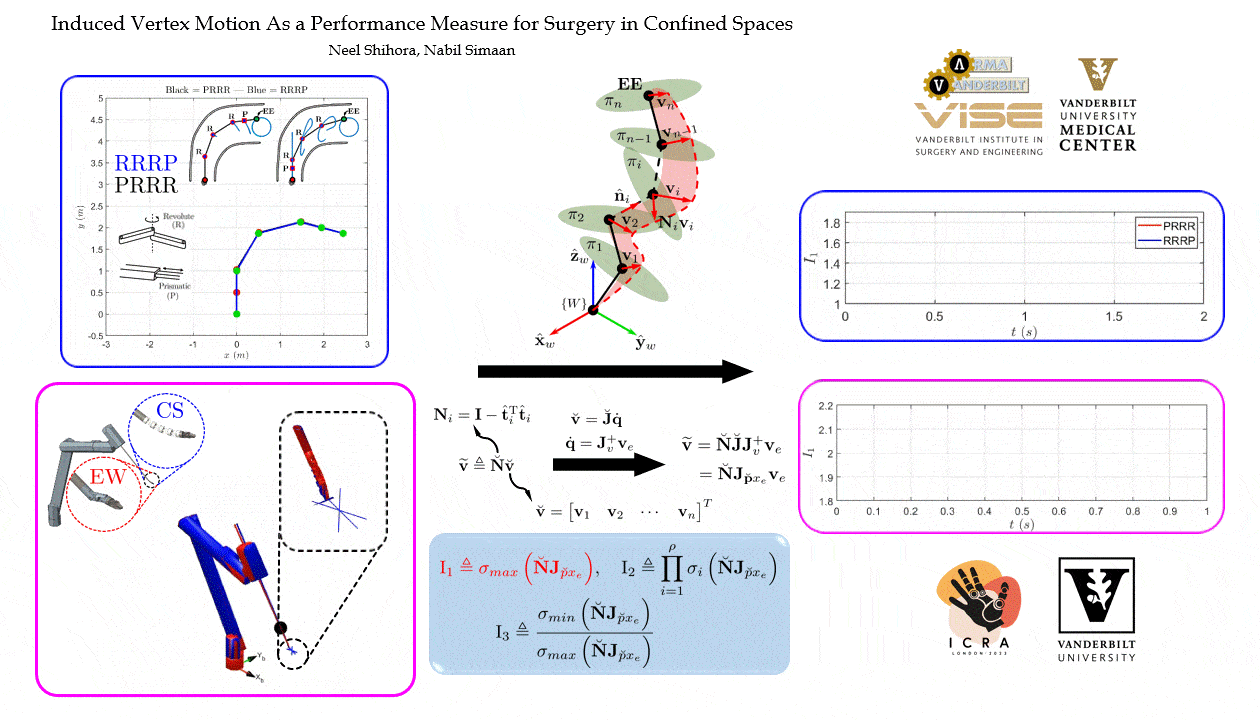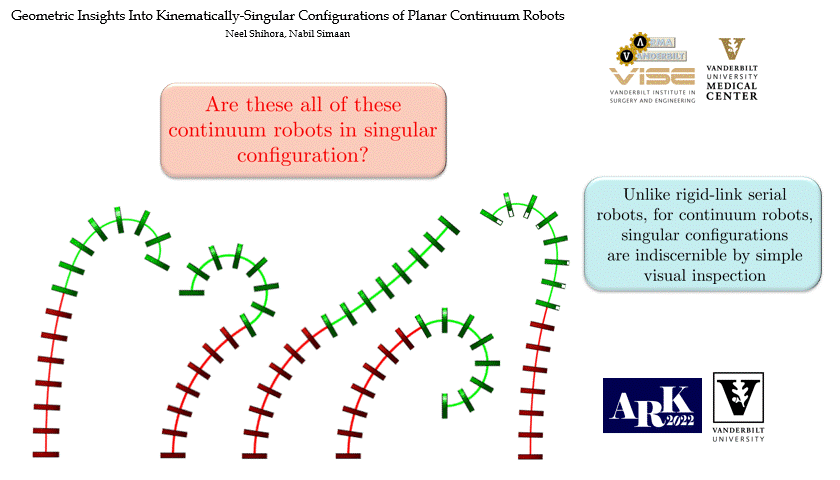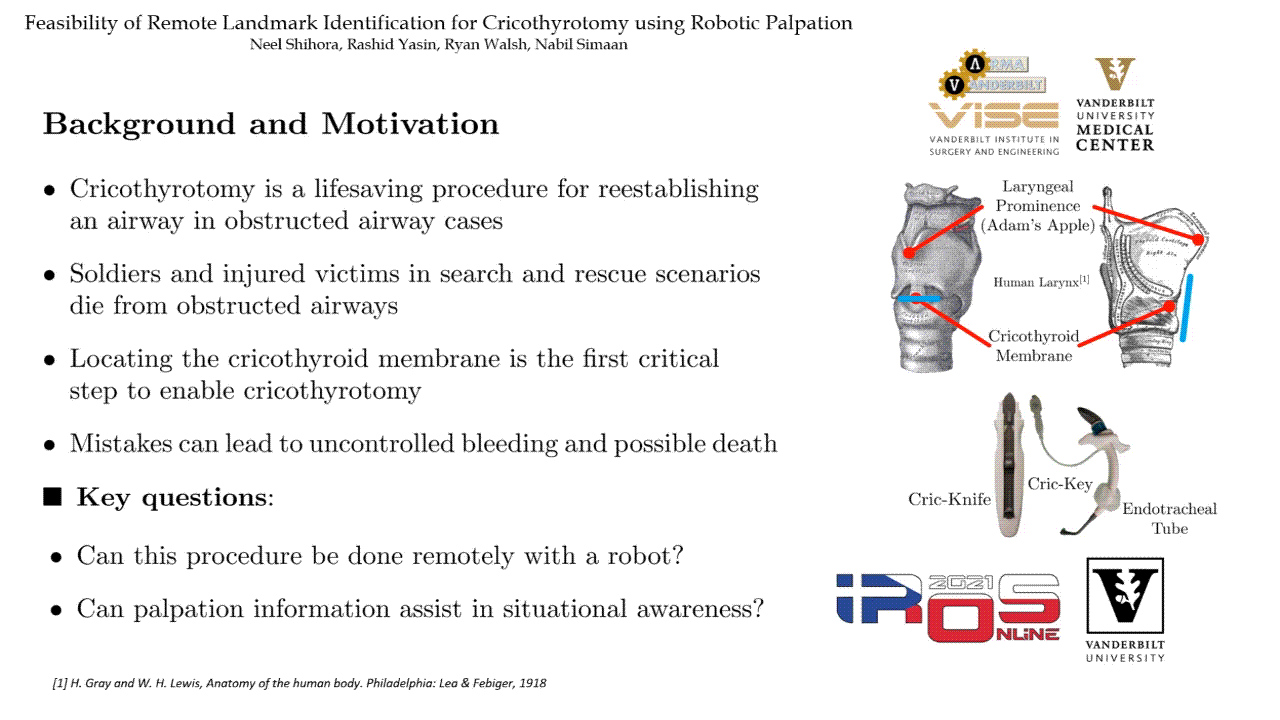About me | Research Work | Bookshelf | Contact
Peer-reviewed journal papers
Elan Ahronovich, Olivia Richards Neel Shihora, Jin H. Shen, Karen Joos, and Nabil Simaan, "Evaluation of Kinematically Redundant OCT-Guided Collaborative Robotic Assistant For Extraocular Subretinal Drug Delivery," IEEE Transactions on Biomedical Engineering, 2024.
(In Preparation)
Neel Shihora and Nabil Simaan, "The Friction-Limited End-Effector Motion Resolution of Tendon-Actuated and Continuum Robots," Mechanisms and Machine Theory, vol. 203, 2024.
MMT | November, 2024 LINK
Neel Shihora, Jared Lawson, Paul Moubarak, Maximillian Reese, Long Wang, and Nabil Simaan, "Redundancy Resolution Strategies and Dexterity Analysis for Wire-actuated Dexterous Devices as Distal Tools in Surgical Robotic Systems," ASME Journal of Mechanisms and Robotics (JMR), 2025.
JMR | June, 2025 LINK
Neel Shihora and Nabil Simaan, "Singularity Analysis of the Continuum Robots: Geometric Insights," ASME Journal of Mechanisms and Robotics (JMR), 2024.
(In Preparation)
G.L.H. Johnston, Neel Shihora, and Nabil Simaan, "A Modal-Space Formulation for Momentum Observer Contact Estimation and Effects of Uncertainty for Continuum Robots," The International Journal of Robotics Research, 2025.
IJRR | June, 2025 LINK
Peer-reviewed conference papers
Olivia Richards, Elan Ahronovich, Neel Shihora, Ahmet Yildiz, Jumana Atoum, Jie Ying Wu, Keith L. Obstein, Nabil Simaan, "A Robotic Mediation Device for Skill Assessment and Training During Colonoscopy," In 2024 IEEE/RSJ International Conference on Intelligent Robots and Systems (IROS), Abu Dhabi, United Arab Emirates, pp. 4616-4623, 2024. (Under Review)
IROS | October, 2024 LINK
Induced Vertex Motion As a Performance Measure for Surgery in Confined Spaces
ICRA | May, 2023 LINK

While in the design phase of a robotic system for the procedures performed in surgical confined spaces or hard-to-reach deep surgical fields, designers can leverage a systematic method to compare the design alternatives for telesurgical manipulators quantitatively. Unlike most of the work in the literature, we propose an approach for comparing design alternatives by considering the spurious motions along the length of the manipulator in lieu of existing approaches looking at only the end-effector dexterity measures. We propose a performance measure quantifying these spurious motions while the end-effector executes the application-critical tasks such as suturing and tying a knot. A good manipulator design should yield minimal swept volume along its length portions within the confined space. If informed about these spurious motions, that design would lead to reduced force on the internal organs, reducing the pain and discomfort as well as occurrences of extracorporeal inter-manipulator collisions. To validate the proposed approach, we present two illustrative simulation case studies: (1) two planar rigid link serial robots performing the task of following a desired trajectory, and (2) two different architectures of tele-surgical manipulators performing the task of passing a circular suture needle under the fulcrum constraints. The results show the applicability of the proposed performance measure in determining the suitability of a particular design alternative for a given task. Although results are promising, using this measure alone for design optimization may compromise overall device dexterity. Therefore, this measure needs to be incorporated into a weighted optimization framework for robot design.
Elan Ahronovich, Neel Shihora, Jin-Hui Shen, Karen Joos, and Nabil Simaan. "Exploring an external approach to subretinal drug delivery via robot assistance and B-Mode OCT." In 2023 IEEE International Conference on Robotics and Automation (ICRA), pp. 6795-6801. IEEE, 2023.
ICRA | May, 2023 LINK
Geometric Insights into Kinematically-Singular Configurations of Planar Continuum Robots
ARK | June, 2022 LINK

Continuum robots present designers with the challenges of interpreting the geometric conditions that lead to singularity. Unlike serial robots, where it is easy to relate Plucker line coordinates to physical locations fixed in each link-attached frame, such geometric understanding is hard to visualize for continuum robots. In this paper, we explore the conditions for the singularity of continuum robots comprised of two and three segments. We derive the conditions for singularity and visualize these singular configurations with their corresponding conditions of singularity. We start the analysis assuming circular curvature, and then we discuss how the same analysis can be extended to non-circular curvature cases. We also define safety regions for singularity that depend on an assumed modal shape variation due to the elastic deflections of these robots. These safety zones can be used to produce designs and path plans that guarantee singularity-free performance despite norm-bounded deflections in configuration space.
Feasibility of Remote Landmark Identification for Cricothyrotomy Using Robotic Palpation
IROS | 2021 LINK

Cricothyrotomy is a life-saving emergency intervention that secures an alternate airway route after a neck injury or obstruction. The procedure starts with identifying the correct location (the cricothyroid membrane) for creating an incision to insert an endotracheal tube. This location is determined using a combination of visual and palpation cues. Enabling robot-assisted remote cricothyrotomy may extend this life-saving procedure to injured soldiers or patients who may not be readily accessible for on-site intervention during searchand-rescue scenarios. As a first step towards achieving this goal, this paper explores the feasibility of palpation-assisted landmark identification for cricothyrotomy. Using a cricothyrotomy training simulator, we explore several alternatives for in-situ remote localization of the cricothyroid membrane. These alternatives include a) unaided telemanipulation, b) telemanipulation with direct force feedback, c) telemanipulation with superimposed motion excitation for on-line stiffness estimation and display, and d) fully autonomous palpation scan initialized based on the user’s understanding of key anatomical landmarks. Using the manually digitized cricothyroid membrane location as ground truth, we compare these four methods for accuracy and repeatability of identifying the landmark for cricothyrotomy, time of completion, and ease of use. These preliminary results suggest that the accuracy of remote cricothyrotomy landmark identification is improved when the user is aided with visual and force cues. They also show that, with proper user initialization, landmark identification using remote palpation is feasible - therefore satisfying a key prerequisite for future robotic solutions for remote cricothyrotomy.
Abah, Colette, Giuseppe Del Giudice, Neel Shihora, Rohan Chitale, and Nabil Simaan. "Towards Semi-Automated Mechanical Thrombectomy: Path Planning Considerations for a Double Articulated Microcatheter." In 2019 Proceedings of the 12th Hamlyn Symposium on Medical Robotics, pp. 67-68. 2019.
HSMR | June, 2019 LINK
Abstracts and Workshop presentations
Neel Shihora, Ryan Walsh, Nabil Simaan, "Feasibility Study of Assistive Telemanipulation Methods for Identifying the Cricothyrotomy Landmark Using Robotic Palpation", in Rising Challenges to En Route Care and Patient Movement, Military Health System Research Symposium (MHSRS), 2021
MHSRS | August 2021
Neel Shihora, Rashid Yasin, Ryan Walsh, Nabil Simaan, "Semi-Autonomous Remote Landmark Identification for Cricothyrotomy using Robotic Palpation", IEEE workshop on Autonomous System in Medicine: Current Challenges in Design, Modeling, Perception, Control, and Applications, IEEE/RSJ International Conference on Intelligent Robots and Systems (IROS), 2020
IROS | October 2020